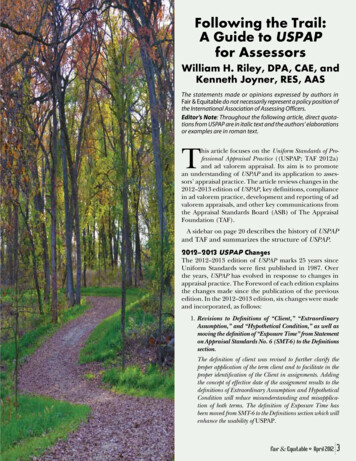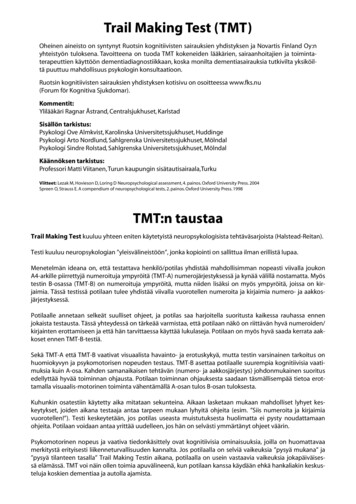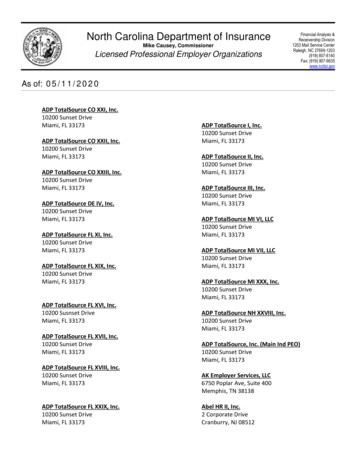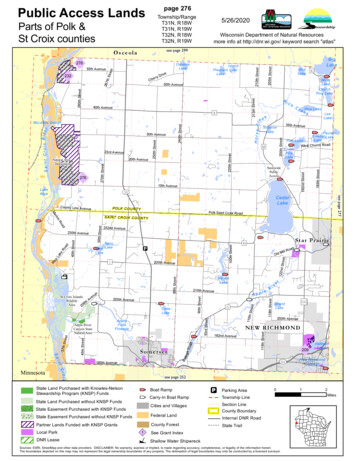
Transcription
Following the Trail:A Guide to USPAPfor AssessorsWilliam H. Riley, DPA, CAE, andKenneth Joyner, RES, AASThe statements made or opinions expressed by authors inFair & Equitable do not necessarily represent a policy position ofthe International Association of Assessing Officers.Editor’s Note: Throughout the following article, direct quotations from USPAP are in italic text and the authors’ elaborationsor examples are in roman text.This article focuses on the Uniform Standards of Professional Appraisal Practice ((USPAP; TAF 2012a)and ad valorem appraisal. Its aim is to promotean understanding of USPAP and its application to assessors’ appraisal practice. The article reviews changes in the2012–2013 edition of USPAP, key definitions, compliancein ad valorem practice, development and reporting of advalorem appraisals, and other key communications fromthe Appraisal Standards Board (ASB) of The AppraisalFoundation (TAF).A sidebar on page 20 describes the history of USPAPand TAF and summarizes the structure of USPAP.2012–2013 USPAP ChangesThe 2012–2013 edition of USPAP marks 25 years sinceUniform Standards were first published in 1987. Overthe years, USPAP has evolved in response to changes inappraisal practice. The Foreword of each edition explainsthe changes made since the publication of the previousedition. In the 2012–2013 edition, six changes were madeand incorporated, as follows:1. Revisions to Definitions of “Client,” “ExtraordinaryAssumption,” and “Hypothetical Condition,” as well asmoving the definition of “Exposure Time” from Statementon Appraisal Standards No. 6 (SMT-6) to the Definitionssection.The definition of client was revised to further clarify theproper application of the term client and to facilitate in theproper identification of the Client in assignments. Addingthe concept of effective date of the assignment results to thedefinitions of Extraordinary Assumption and HypotheticalCondition will reduce misunderstanding and misapplication of both terms. The definition of Exposure Time hasbeen moved from SMT-6 to the Definitions section which willenhance the usability of USPAP.Fair & Equitable April 20123
Feature Article2. Creation of a new Record Keeping Rule and RelatedEdits to the Conduct Section of the Ethics Rule.The Board heard concerns about the location of recordkeeping requirements within the Ethics Rule. Afterexposing the concept of moving record keeping into aseparate Rule, it was determined that record keepingshould be a separate Rule. However, a provision wasadded to the Ethics Rule so that anyone who willfullyor knowingly violates the Record Keeping Rule is alsoin violation of the Ethics Rule.3. Revisions Relating to Development and Disclosureof Exposure Time Opinion.In order to assure that intended users understand thecontext in which the opinion of value is developed, theBoard has adopted revisions to make it a clear requirement that reasonable exposure time must be reportedin all assignments in which an opinion of reasonableexposure time must be developed. As clarified in the2012–2013 edition of USPAP, exposure time mustbe developed When exposure time is a component ofthe definition for the value opinion being developed.4. Revisions to Standards Rules 2-3, 3-6, 5-3, 6-9, 8-3,and 10-3 (signed certification statement).The 2010–2011 edition of USPAP initiated the requirement to disclose any services regarding the subjectproperty performed by the appraiser within the prior threeyears in the report certification. Another requirement ofUSPAP is the appraiser must disclose in the certificationeither the presence or absence of any current or prospective interest regarding the subject or the parties involved.To improve consistency, for the 2012–2013 edition ofUSPAP the Board is requiring that prior service(s)regarding the subject property be treated similarly in thecertification as current/prospective interests are treated.5. Revisions to Standards 7 and 8: Personal PropertyAppraisal, Development and Reporting.The changes to Standards 7 and 8 were, in large part,the result of the work of an appointed task force madeup of personal property appraisers. It had been severalyears since a comprehensive review had been made ofStandards 7 and 8, and after a thorough review, thetask force made numerous recommendations to theBoard, most of which were adopted by the Board.6. Revisions to Advisor y Opinion 21, USPAPCompliance.The revisions to Advisory Opinion 21 were made inresponse to questions and concerns from appraisers, appraisal clients and state appraisal regulatory officials.4 Fair & Equitable April 2012Advisory Opinion 21 (AO-21) contains a series of questions with responses along with illustrative examples.The illustrations in AO-21 were reviewed and updatedor replaced as necessary to provide relevant guidanceregarding when USPAP applies. (TAF 2012a, U-vi)DefinitionsKey USPAP definitions are as follows:Appraisal: (noun) the act or process of developing anopinion of value; an opinion of value. (adjective) of orpertaining to appraising and related functions such asappraisal practice or appraisal services.Appraisal Practice: valuation services performed by anindividual acting as an appraiser, including but notlimited to appraisal, appraisal review, or appraisalconsulting.Appraiser: one who is expected to perform valuation services competently and in a manner that is independent,impartial, and objective.Mass Appraisal: the process of valuing a universe ofproperties as of a given date using standard methodology,employing common data, and allowing for statisticaltesting.Mass Appraisal Model: a mathematical expression ofhow supply and demand factors interact in a market.Report: any communication, written or oral, of anappraisal, appraisal review, or appraisal consultingservice that is transmitted to the client upon completionof an assignment.Scope of Work: the type and extent of research and analyses in an assignment.Workfile: documentation necessary to support an appraiser’s analyses, opinions, and conclusions. (TAF2012a, U-1 to U-5)Standard 6: Mass Appraisal, Developmentand ReportingStandard 6 deals with the development and reportingrequirements of a mass appraisal. Development is all thework that is done to complete a credible appraisal,while reporting is the communication of the appraisal.The first Comment in the Standard provides perspective on mass appraisal:Comment: Standard 6 applies to all mass appraisals ofreal or personal property regardless of the purpose or useof such appraisals. Standard 6 is directed toward thesubstantive aspects of developing and communicatingcredible analyses, opinions, and conclusions in the mass
appraisal of properties. Mass appraisals can be preparedwith or without computer assistance. The reporting andjurisdictional exceptions applicable to public mass appraisals prepared for ad valorem taxation do not applyto mass appraisals prepared for other purposes.A mass appraisal includes:(1) identifying properties to be appraised;(2) defining market area of consistent behavior that appliesto properties;(3) identifying characteristics (supply and demand) thataffect the creation of value in that market area;(4) developing a model structure that reflects the relationship among the characteristics affecting value in themarket area;(5) calibrating the model structure to determine the contribution of the individual characteristics affecting value;(6) applying the conclusions reflected in the model to thecharacteristics of the property(ies) being appraised; and(7) reviewing the mass appraisal results. (TAF 2012a,U-46)Assessor’s OfficeAn assessor’s work is often misunderstood by the public, appraisers, and users of appraisal services. Whileassessors use the recognized methods and techniquesof both single-property appraisal and mass appraisal,the uniqueness and timing of the assessor’s work cancause misunderstanding of how USPAP applies toad valorem practice.The person responsible for all appraisals and thework in the assessor’s office is the assessor (also calledSupervisor of Assessments, Chief Assessor, PropertyAppraiser, and so forth). The assessor performs thework of the office through a staff that includes bothclerical and appraisal personnel.appraisals. The key difference in mass appraisal is thesize and scope of the assessor’s assignment, whichmay require production line methods and techniques.Appraisal DevelopmentAn assessor should plan for a mass appraisal for advalorem purposes. In general, the assessor is performing a mass appraisal of a universe of properties. Theassessor typically values the universe of propertiesusing Standard 6.The assessor may develop one or several mass appraisal models. However, the assessor may decide toappraise certain properties using single-property appraisal methods under Standard 1 and Standard 2,which may be part of the revaluation, and appraiseothers using mass appraisal methods under Standard6. It is up to the appraiser or assessor to decide whichof the Uniform Standards to use, based on the scopeof work. For most ad valorem mass appraisals, Standard6 is used.Essentially, an appraisal under Standard 1: Real Property Appraisal, Development is made by using a mathematical model (although it is not referred to as suchin that Standard). Individual property may be valued byusing one or more of the three traditional approachesto value. Examples of these models are as follows:For the cost approach,V RCNLD LVwhereV valueRCNLD replacement cost new less depreciationLV land value.For the sales comparison approach,V SP ADJIn general, the definition of value is given in statute or case law. The effective date of the appraisaland the requirements for valuation (often periodic)are specified in law or regulation. There is usuallya certification of assessments for all property, a dueprocess notice, and an appeal procedure for propertyowners. Often there are requirements to make copiesof property record cards, sales listings, sales analyses, and other meaningful information accessible toproperty owners.whereIn appraisals for ad valorem purposes, manyaspects of the appraisals are similar to single propertyIf Standard 1 is used to value a property, the appraiser conducts the appraisal process by applying theSP sale priceADJ adjustment to sale price.For the income approach,V I RwhereI sale priceR capitalization rate.Fair & Equitable April 20125
Feature Articlesteps in developing the appraisal under Standard 1.If Standard 6 is used to value property, the appraiserconducts the appraisal process by applying the stepsin developing the appraisal under Standard 6. A singleproperty or a universe of properties can be appraisedby using Standard 6. The appraiser must decide whichStandard will be used. Development of the appraisalis all the work necessary to produce credible assignment results.The Appraisal ProcessThe appraisal process is the method by which appraisers solve appraisal problems. There are six keysteps for the development and reporting of appraisals under Standards 1 and 2 or Standard 6. Althoughmany of the Standards Rules are the same betweenStandards 1 and 2 and Standard 6, there are somedifferences. The appraiser must decide which Standard to use for the assignment and then follow theapplicable Standards Rules.The following are the six steps in the appraisal process:1. Definition of the problem2. Scope of work3. Data collection and analysis4. Application of the approaches to value5. Reconciliation of value indicators and final valueopinions6. Report of the defined value opinion (TAF2012b, 1-20).Table 1, prepared by The Appraisal Foundation(TAF 2012b, 1-21), illustrates the steps in the appraisalprocess. We have expanded it to also reflect the Standards or Rules applicable to each step.Because the emphasis in this article is on the practical applications of USPAP to the assessor, the following discussion focuses on the development of a massappraisal under Standard 6.Standards Rules 6-1 to 6-7 cover the requirementsfor development of a mass appraisal. These StandardsRules follow the first five steps of the appraisal process.The general obligations of Standard 6 are found inStandards Rule 6-1, which requires thatIn developing a mass appraisal, an appraiser must:(a) be aware of, understand, and correctly employ thoserecognized methods and techniques necessary to produce a credible mass appraisal; .Table 1. Six steps in the appraisal process under Standards 1, 2, and 6Step 1. Definition of the ProblemIdentify client and Identify the Identify effective Identify the type Identify relevantother intendedintended use value dateand definition of characteristics ofusevaluethe propertyAssignment conditions*Extraordinary Hypotheticalassumptions conditionsCompetency RuleScope of Work RuleStep 2. Scope of WorkStep 3. Data Collection and AnalysisMarket AnalysisDemand studiesSupply studiesMarketability studiesStandard Rule 1-2Standard Rule 6-1Highest and Best Use AnalysisSite as though vacantIdeal improvementProperty as improvedStep 4. Application of the Approaches to ValueCostSales ComparisonIncome CapitalizationStandard Rule 1-3Standard Rule 6-3Standard Rule 1-4Standard Rules 6-4,6-5, and 6-6Step 5. Reconciliation of Value Indicators and Final Value OpinionStandard Rule 1-6Standard Rule 6-7Step 6. Report of Defined Value OpinionsStandard 2Standard Rules 6-8and 6-9* Assignment conditions also include jurisdictional exceptions, assumptions, and limiting conditions6 Fair & Equitable April 2012
(b) not commit a substantial error of omission or commission that significantly affects a mass appraisal; and (c) not render a mass appraisal in a careless or negligentmanner. (TAF 2012a, U-46)Step 1. Definition of the ProblemThe first step in the appraisal process is problemidentification, the requirements for which are foundin Standards Rule 6-2. The appraiser must identifythe following: Client and intended users Intended use Type and definition of value Effective date of value Relevant property characteristics Assignment conditions, including– Extraordinary assumptions– Hypothetical conditions.The appraiser is required to consider these keypoints in the development of an appraisal or mass appraisal. The appraiser must have competency (properjudgment, knowledge, and experience) to identifythe appraisal problem and to be able to develop anappropriate scope of work.When considering an assignment, an appraiserproceeds through the nine steps of problem identification by following Standards Rules 6-2 (a) through6-2 (i). After analyzing and completing these ninesteps, the appraiser determines the scope of work toproduce credible results according to the Scope ofWork Rule.Key to an acceptable scope of work is credible assignment results. To determine an acceptable scope ofwork, an assessment office must evaluate the needsof the assignment when beginning or starting the appraisal. An honest self-evaluation of the quality andquantity of data and information currently possessedor easily accessed is needed, as well as the systemsthat can produce credible assignment results (Joyner2010).Identify the Client and Intended UsersAn appraisal or mass appraisal completed by the assessor typically does not follow the same work process asan appraisal for lending purposes. The assessor doesnot necessarily receive an order for the mass appraisalfrom the client.The USPAP definitions of client and intended userare as follows:Client: the party or parties who engage, by employmentor contract, an appraiser in a specific assignment;Intended User: the client and any other party as identified, by name or type, as users of the appraisal, appraisalreview, or appraisal consulting report by the appraiser onthe basis of communication with the client at the time ofthe assignment. (TAF 2012a, U-2 to U-3)Additional guidance on the applicability of the Standards is given in Advisory Opinion 32 (AO-32), AdValorem Appraisal Assignments and Mass Appraisal,which states,In ad valorem taxation assignments, the client is typically the government or taxing authority that engagesthe appraiser. As defined in USPAP, the intended usersinclude the client. Through communication with theclient, the appraiser may identify other intended users.A party receiving a copy of a report in order to satisfydisclosure requirements does not become an intended userof the appraisal or mass appraisal unless the appraiseridentifies such party as an intended user as part of theassignment. (TAF 2012a, A-108)Assessors are typically employed by the client—thelocal government. Sometimes a local government maycontract with a private appraisal firm to complete thevaluation. For each appraisal or mass appraisal, it is theresponsibility of the appraiser or assessor to identifythe client and intended users of the appraisal.Statement 9, Identification of Intended Use and Intended Users, elaborates on the USPAP requirementsplaced on the appraiser or assessor for identificationof the intended use and of intended users of an appraisal or mass appraisal. The Statement clarifies thatthe appraiser must have communication with the client and determine the intended use and intendedusers prior to acceptance of the assignment. This communication is important in order to develop credibleassignment results and to provide an appraisal that ismeaningful and not misleading.The assessor should be aware of the requirementsof Statement 9, as well as any statutory, regulatory,or administrative requirements regarding clients,intended users, or intended uses of the assignment.The guidance on the applicability of the UniformStandards in AO-32 states,A party receiving a copy of a report in order to satisfydisclosure requirements does not become an intended userof the appraisal or mass appraisal unless the appraiserFair & Equitable April 20127
Feature Articleidentifies such party as an intended user as part of theassignment. (TAF 2012a, A-110)Therefore, a property owner receiving an assessment notice, property record card, appraisal report,or sales analysis is not an intended user of the appraisal or mass appraisal unless the property owneris identified as an intended user by the appraiser atthe time of acceptance of the assignment.This is similar to an appraisal made for lending purposes. In these assignments the client is the lender;the party applying for the loan is not normally an intended user. Yet the party applying for the loan mayobtain information about the appraisal.Identify the Intended UseThe USPAP definition of intended use is as follows:Intended Use: the use or uses of an appraiser’s reportedappraisal, appraisal review, or appraisal consultingassignment opinions and conclusions, as identified bythe appraiser based on communication with the client atthe time of the assignment. (TAF 2012a, U-3)Mass appraisals are generally used for ad valoremproperty tax purposes but may be used for otherpurposes. The phrasing of the intended use for anad valorem appraisal might be, “Use of this appraisaland its conclusions is limited to the assessment ofproperty for the administration of property taxes according to the governing laws of (name of jurisdiction).” (IAAO 2011)Whether or not assignment results are credible ismeasured in the context of the intended use of theopinions or conclusions. Statement 9 should be readin detail for further clarification of intended use.Identify the Type and Definition of ValueThe appraiser or assessor must identify the type anddefinition of value as part of the problem identification process. For ad valorem mass appraisal assignments, the definition of value is often defined andfound in statute or case law. In reporting the appraisalor mass appraisal, the appraiser must state the typeand definition of value and must give the citation ofthe source.Identify the Effective Date of ValueThe appraiser or assessor must identify the effectivedate of value as part of the problem identificationprocess. In USPAP, there are two dates: the effectivedate of the appraisal and the date of the report. Theeffective date of the appraisal establishes the contextfor the value opinion. The date of the report indicates8 Fair & Equitable April 2012the perspective of the appraiser on the market andproperty as of the effective date of appraisal. That is, ifthe effective date is after the report date, the appraiserperspective is prospective; if the effective date and thereport date are contemporaneous, the perspective iscurrent; if the effective date is prior to the report date,the perspective is retrospective.Statement 3, Retrospective Value Opinions, shouldbe consulted concerning this issue, because ad valorem mass appraisals are generally retrospectivevalue opinions.Identify the Relevant Property CharacteristicsStandards Rules 6-2 (e) to 6-2 (i) address the identification of relevant property characteristics. Appraisersshould review these Standards Rules in detail. Someof the key points are as follows: Identify the characteristics of the properties that are relevant to the type and definition of value and intendeduse, The USPAP Comment for these states,The properties must be identified in general terms,and each individual property in the universe must beidentified, with the information on its identity stored orreferenced in its property record. Identify the characteristics of the market that are relevantto the purpose and intended use of the mass appraisal Analyze the relevant economic conditions at the timeof the valuation, including market acceptability of theproperty and supply, demand, scarcity, or rarity; (TAF2012a, A-77)Identify the Extraordinary Assumptions and Hypothetical ConditionsUSPAP defines extraordinary assumptions and hypothetical conditions as follows:Extraordinary Assumption: an assumption, directlyrelated to a specific assignment, as of the effective date ofthe assignment results, which, if found to be false, couldalter the appraiser’s opinions or conclusions.Comment: Extraordinary assumptions presume as factotherwise uncertain information about physical, legal,or economic characteristics of the subject property; orabout conditions external to the property, such as marketconditions or trends; or about the integrity of data usedin an analysis.andHypothetical Condition: a condition, directly related to aspecific assignment, which is contrary to what is known
by the appraiser to exist on the effective date of the assignment results, but is used for the purpose of analysis.Comment: Hypothetical conditions are contrary to knownfacts about physical, legal, or economic characteristics ofthe subject property; or about conditions external to theproperty, such as market conditions or trends; or about theintegrity of data used in an analysis. (TAF 2012a, U-3)Two examples of extraordinary assumptions in massappraisal are as follows:1. Property characteristics are correct2. A property does not have environmental ormold contamination.In the first example, the appraiser is assuming thatthe property characteristics are correct, but if theyare found to be in error they may “alter the appraisers opinion.” In the second example, if an appraiseris appraising in an area where homes have beenreported to have environmental contamination ormold contamination but does not know for certain ifa property has contamination, the appraiser may usean extraordinary assumption that the property is freefrom contamination. If the property was found to havecontamination, that may alter the appraiser’s opinion.Examples of hypothetical conditions in mass appraisal could be a condition in which:1. A vacant parcel is appraised with an improvement on the parcel.2. A property with mold, pollution, fire damage, orthe like is appraised as if the repairs or remediation has been done.3. A large parcel of land is appraised as if it is subdivided for lots with improvement to the landcompleted (streets, utilities, curbs and gutters,street lights, and so on).In the first example, the appraiser knows that theparcel is vacant but is using a hypothetical conditionand appraising it as if it had an improvement. This isoften done in collateral loan appraisal, and it wouldprobably be rare for an assessor to do this since theassessor would be appraising the improvement whenit is first completed.In the second example, the assessor knows that theproperty has roof damage or minimal fire damagebut knows that it is being repaired quickly. By usingthe hypothetical condition that the property was notdamaged, the assessor could appraise it for the nexttax year as if the condition did not exist.In the third example, the assessor knows that theproperty is vacant but knows that it has been subdivided for building lots. The assessor can see that the subdivision improvements to the land are being completed(streets, utilities, curbs and gutters, street lights) but arenot complete upon inspection. By using a hypothetical condition that the subdivision improvements arecomplete, the assessor could appraise the property asimproved building lots for the next tax year.Hypothetical conditions can be confusing becausethey relate to an assessor’s work. As stated, a hypothetical condition is something that is contrary to fact.In ad valorem appraisal, many states have laws thatprohibit placing property on the tax roll until it iscomplete. In other states, however, it may be placedon the roll for a portion of the year regardless ofwhether it is complete. This can be true for an entirestructure, a room addition, or a remodeling.For states in which the property is not placed onthe tax roll until it is complete even though it exists, ahypothetical condition is imposed by law. If a portionof the property exists but is not complete, the property is either appraised as if unimproved (vacant) oras if the new improvements do not exist (lacking theroom addition or not yet remodeled).In contrast to other appraisal uses in which the hypothetical condition is determined between the appraiser and the client, in ad valorem appraisal the hypothetical condition most often is established by law.Other examples of hypothetical conditions in assessment work might include improvements to encouragean action through a public policy (law) that wouldnot subject certain improvements to taxation. A lawmight state that smoke detectors, fire standpipes, orfire sprinkler systems are not assessed or taxed. Inother states a law might state hurricane straps andanchors, window shutters, or storm-proof glass are notto be assessed. If an assessor is appraising a propertythat has improvements that are not to be assessed, ahypothetical condition exists. The property has theimprovement, but the assessor is not appraising it.Another example is an enterprise zone or redevelopment district, which prohibits by law the assessmentof new improvements to property within the zone fora period of years even though they exist. This wouldbe an example in which the assessor would use a hypothetical condition.Fair & Equitable April 20129
Feature ArticleStep 2. Scope of WorkAs defined in USPAP, scope of work is “the type andextent of research and analyses in an assignment.”Problem identification is a process of gathering andanalyzing information for the purpose of making ascope of work decision. Thus, the assessor must firstcomplete Step 1 (Definition of the Problem) beforethe scope of work can be established.The assessor’s objective is to produce a crediblemass appraisal. Therefore, the assessor is requiredto have the knowledge and experience to completethe mass appraisal assignment competently, whichrequires both proper judgment and performance.(TAF 2006, 76).The minimum requirements for a scope of workare found in Standards Rule 6-2 and in the Scope ofWork Rule. The three key provisions of the Scope ofWork Rule are as follows:1. Identify the problem to be solved.2. Determine and perform the scope of work necessary to develop credible assignments results.3. Disclose the scope of work in the report.Appraisers have broad flexibility and significantresponsibility in determining the appropriate scopeof work for an appraisal. Credible assignment resultsrequire support by relevant evidence and logic. Credibility of assignment results is always measured in thecontext of intended use. The scope of work must include the appropriate research and analyses necessaryfor credible results. (TAF 2012a, U-13).Although the Scope of Work Rule and most of theassociated advice reflect a single-property appraisalperspective, the basic requirements pertain to massappraisal as well. Therefore, “the assessor must determine annually the work to be accomplished, including valuation strategies, data to be collected, and anyrefinements to existing procedures” (Gloudemansand Almy 2011, 9).The assessor is responsible for the discovery, listing,and valuation of all property within a jurisdiction.These are important steps in assessment. Althoughthese steps may appear simple, they are complex.Except for unusual properties that might requirethe use of single-property appraisal techniques, advalorem appraisals are based on initial value estimatesfrom a mass appraisal system (Gloudemans and Almy2011, 20). This requires a much more complex scope10 Fair & Equitable April 2012of work than one for the appraisal of one singleproperty appraisal.As part of a scope of work for a mass appraisal assignment, the assessor must consider and evaluatethe quantity and quality of the existing resources toproduce a credible mass appraisal and what mightbe needed. These considerations include financial,staffing, and systems resources; valuation systems andsupport; computer-assisted mass appraisal (CAMA);geographic information; imagery; and property salesand data resources. The assessor must consider whether appropriate recognized methods and techniquesare being employed or need to be implemented toproduce a credible mass appraisal (Joyner 2010).Because of financial commitme
USPAP is the appraiser must disclose in the certification either the presence or absence of any current or prospec-tive interest regarding the subject or the parties involved. To improve consistency, for the 2012–2013 edition of US











